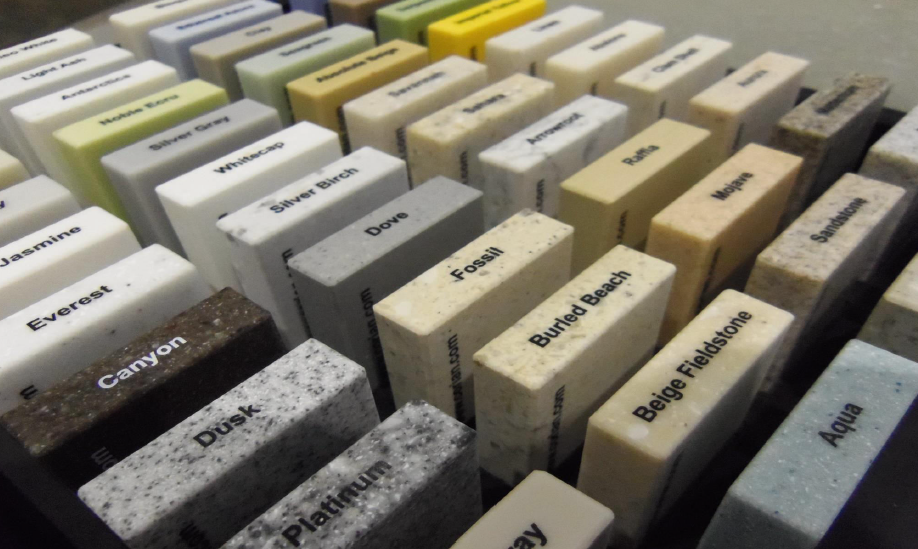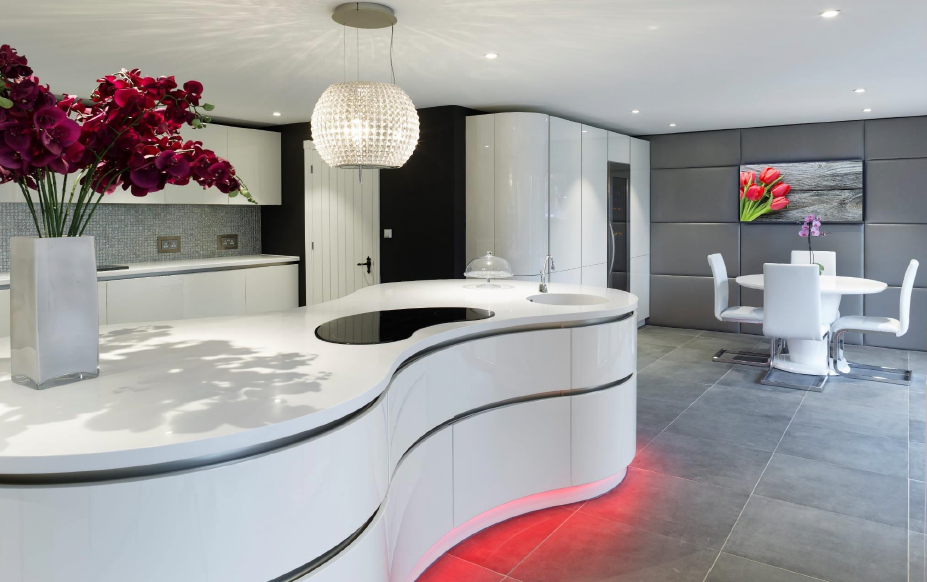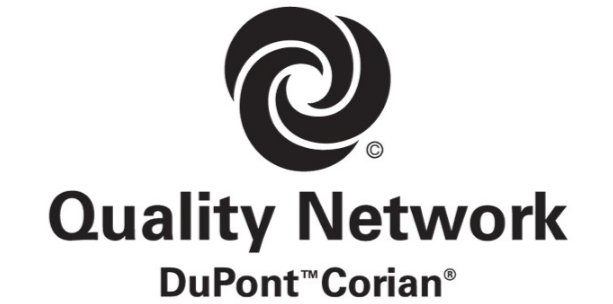If you are searching for an answer to the question “What Is Corian?”, you are not alone.
People just like you and I carry out around seven thousand searches every month on Google for the word “Corian”. It’s a really popular product…
Having helped interior designers and private clients on their commercial and residential projects we have come to answer this question many times. So whenever they ask the question “What Is Corian?” we are happy to explain and show them examples of our work.
So I’m going to answer this question and give some pointers that will help you have a greater understanding of what Corian is, and what Corian can do as a product.
What Is Corian?
Created by a company called Dupont in 1967, Corian is a solid, non-porous surface material.
Dr Donald Slocum was the Dupont Scientist who invented Corian and it’s his name that appeared on the patent in October 1968.
Corian first came on sale in 1971 at the National Association of Home Builders exhibition in Houston, Texas. Visitors to the exhibition thought Corian was only a kitchen and bathroom material because it only came in one colour – White.
Today, however, Corian has a vibrant range of 93 colours.

How Is Corian Made?
Corian is made from a mixture of 1/3rd acrylic polymer and 2/3rd natural minerals. The main ingredient is Alumina Trihydrate. This is derived from Bauxite Ore which is one of the main components in the manufacture of Aluminium.
When you slice through a sheet of the finished material the cross-section cut shows a consistent colour. The particulate patterning is evenly distributed throughout the material and this is what gave rise to the phrase “Solid Surface”.
Rather than explain the manufacturing process in detail here’s a short video (5.56 mins) which explains the process. The first minute or so explains the origin of Dupont and their start in manufacturing gunpowder after which it will give you some useful information on the Corian manufacturing process.
The video has the quality of a poor “B” movie but the technical information is pretty good.
The same tools used for working hardwood are used for working Corian… This is why you will find that most Corian fabricators have trained as carpenters or cabinet makers and work from a joinery workshop.
Where Is Corian Manufactured?
‘The manufacturing facility responsible for the majority of Corian production is in Buffalo near New York where the Corian is then distributed to all across the USA. It is also distributed from Buffalo to Corian distributors globally.
Manufacturing plants also operate in Turkey, South Korea and China producing a huge volume of Corian sheets in one continuous production line. These are also exported globally.
What Is The Size Of A Corian Sheet?
Standard dimensions of the 12mm sheets are 760 mm x 3680 mm, although Glacier White Corian is also available in a wider sheet measuring 910mm x 3680mm. In some select colours they offer thinner sheets measuring 6mm x 760mm x 2490mm.
What is Thermoforming For Corian?
One of the fabulous features of Corian is that you can create almost any shape you want once it’s heated. This process is called thermoforming.
To create 2D and 3D items you first heat the Corian to the correct temperature in an oven and then place it on a metal or wooden mould at a controlled temperature. It is then “vacuum packed” to hold the piece in the correct position until it sets hard.
The Bas Relief technique also allows you to create embossing effects
Here’s a great video that shows in more detail the thermoforming process. Check out the similarity to spaghetti.
What Is Corian Used For?
Most people think of Corian as a worktop for kitchens such as this beautiful curved and thermoformed example. It’s stunning…

However Corian is much more versatile than that. There are hundred’s of uses for Corian. And here are some of the more common ones:
• Kitchens
• Bathrooms
• Commercial Offices
• Hygienic Healthcare Areas
• Retail Outlets
• Catering and Hospitality
• Five Star Hotels
• Stunning Furniture
• Bright Lighting Solutions
• External Cladding
If you would like more information please let us know in the comments below.
Five Frequently Asked Questions – With Answers
Clients regularly ask us these five common questions. And hopefully the answers will help you.
Does Corian Scratch?
The answer is yes, particularly in darker colours where scratches are more visible than on a white surface. A Corian craftsman can usually remove the scratch by carefully sanding and polishing it out. With granite you cannot remove scratches.
Is Corian Heat Proof?
Thermoforming allows Corian to become flexible. And when flexible it becomes pliable and easily moulded as we have already explained.
Hot pans or burning cigarettes will leave a burn mark when left on a Corian surface for a long time.
However sanding the surface of the Corian can remove the stain. In really bad cases you can cut the damaged area out and replace it to match the existing. This is another great feature of Corian.
If you are installing Corian in commercial kitchens you need to be careful how you do it. Before acting we suggest calling us or calling your local Corian distributor for specification details.
Does Corian Stain?
Yes it does stain. You can usually remove stains quite easily though. A simple combination of 1/3 bleach, 2/3 water can get rid of almost any stain.
How do you join Corian together?
Some of the workmanship we see by Corian fabricators who are not part of the Corian Quality Network are to say the least “amateur”.
As they don’t know how to work with Corian properly all they do is glue sheets together. This looks terrible and usually results in the joints falling apart.
By using Corian Quality Network approved craftsmen, you can trust that the proper methods and procedures will have been adhered to.
The correct way of joining sheets or component parts together is to first create a “check” and “rebate” in the Corian. You then carefully sand and wipe down both sides with a clean lint free cloth and ethanol solution to provide a clean surface.
Next you apply the adhesive under even pressure and leave the joint to set. Once this is set, excess adhesive is removed from the surface. You then polish it with a sander, which leaves a strong and inconspicuous joint that is invisible to the naked eye.
Why Is Corian So Expensive?
Some people consider Corian to be expensive but not us.
The Corian product is so robust that it lasts for ages. And if it is ever damaged it can be easily repaired by cutting out and replacing the damaged section. This is far more cost effective than regularly replacing an entire section of inferior material.
Better still you will not be able to see a join if the repair is carried out by a qualified Corian craftsman.
Who Sells Corian?
If you are looking to place an order you should look for a Corian fabricator approved by the Corian distributor in your country. The price you receive will depend on the bulk volume you are ordering.

Colinton Furniture is recognised as a Corian fabricator in the UK. So if you would like us to offer advice or need more information on Corian please contact us here.
Is Corian Perfect For Your Next Project?
Hopefully we have answered your question “What Is Corian”… And now you know more about Corian you’re probably wondering if Corian is the perfect material for you to use in your home, office of commercial project.
If you are looking for more information about Corian, we at Colinton Furniture offer a consultancy service. Here we can show you what we can do with Corian… including design, manufacture and installation.
So if you’ve got any questions please feel free to comment below and will get back to you. Or alternatively you can contact us here.
- What Is Corian? (What Is) - November 26, 2016




Can you please list the process techniques from raw material to finished product? Thanks
Hey Azam!
Just wondering whether you mean from material manufacturing to a sheet of Corian. Or if you mean from a sheet of Corian to say a reception desk?
Let me know and i will be happy to help.
Thanks,
Danielle
Dear Mr.Colinton,
I’d like to know from Material manufacturing to Sheet of Corian, if you could send me some related study material which explain how to fabricate Corian Solid surface and what are the process techniques, I’m asking because I’ve recently started research on Solid surfaces in University and your help and supporting arguments will help me a lot I believe. Thank you
Hey Azam,
Why don’t you drop me an email and I can see how we can help you!
My email is daniellew@colintonfurniture.co.uk
Thanks,
Danielle
Thanks Mr. Danielle,
I sent an email, please have a look.
Azam Ali Khan